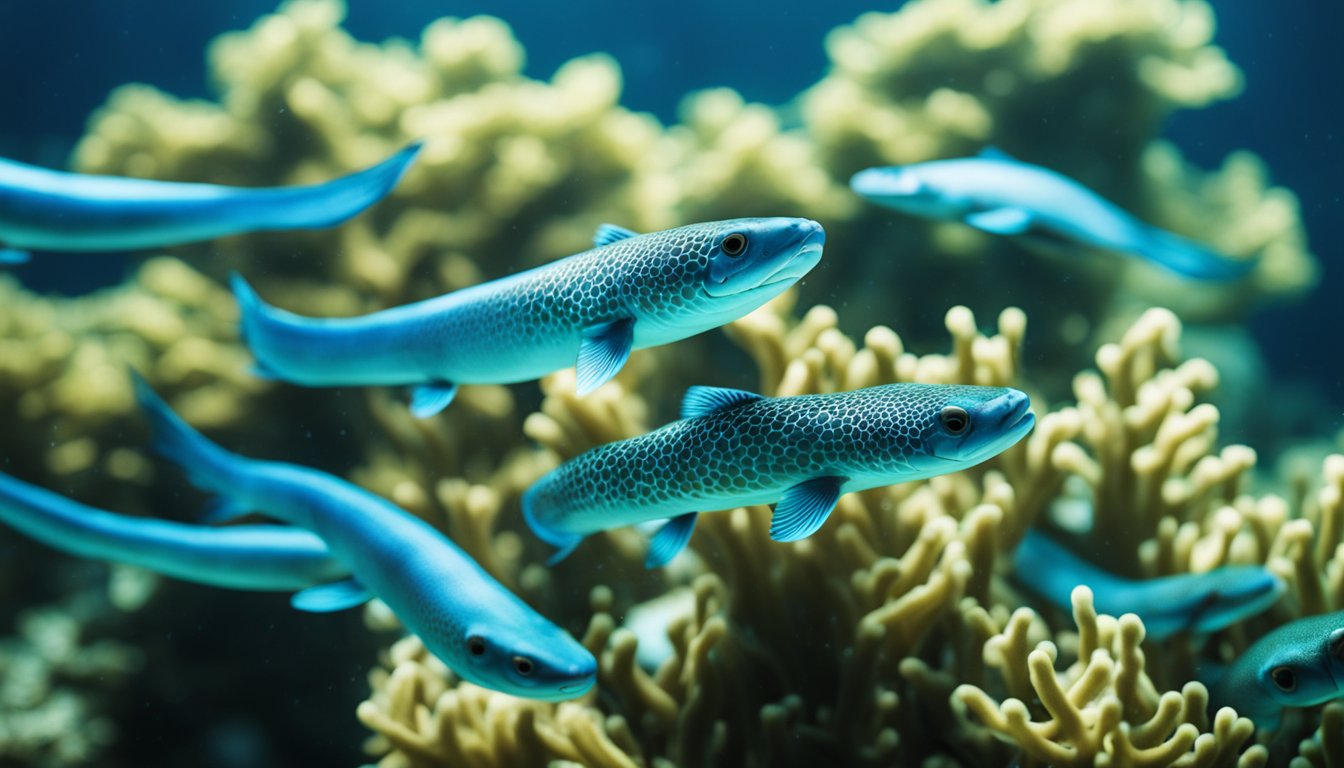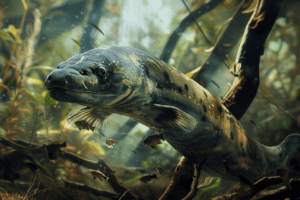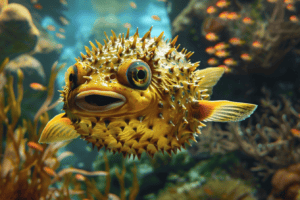Ocean Wanderers: The Migration Mysteries of Eels

The ocean is a vast and mysterious place, home to countless creatures big and small.
Among the most fascinating of these are eels, which are known for their long and slender bodies and their ability to migrate vast distances across the open sea.
But how do these creatures manage to navigate such treacherous waters, and what drives them to travel such great distances?
For centuries, scientists have been intrigued by the migration patterns of eels, which are known to travel from their freshwater homes to the open ocean and back again.
Some eels are known to travel thousands of miles during their lifetimes, crossing entire oceans and navigating through complex currents and changing water temperatures.
Despite their incredible journeys, however, much about the migration patterns of eels remains a mystery, and scientists continue to study these creatures in order to unlock the secrets of their remarkable migration.
Eel Migration: An Ocean Odyssey

Eels are known for their incredible migration journeys, which take them across vast distances of the ocean.
These mysterious creatures are born in freshwater rivers and streams, but spend most of their lives in the open ocean before returning to their birthplace to spawn and die.
Life Cycle of Eels
The life cycle of eels is a fascinating one. Eels start their lives as tiny, transparent larvae that drift with the ocean currents.
As they grow, they develop a distinctive body shape, with a long, slender body and a pointed head.
They also develop a keen sense of smell, which helps them navigate the ocean and find their way back to their home rivers and streams.
As they approach the end of their lives, eels undergo a remarkable transformation.
Their bodies change color, their eyes become larger, and their skin becomes thicker and tougher.
They also stop eating and start swimming towards their home rivers and streams, where they will spawn and die.
The Sargasso Sea Enigma
One of the most mysterious aspects of eel migration is their journey to the Sargasso Sea.
This vast area of the Atlantic Ocean, located east of Bermuda, is the only known spawning ground for eels.
However, no one has ever witnessed eels spawning in the wild, and the exact location of their breeding grounds remains a mystery.
Scientists believe that eels may use the Earth’s magnetic field to navigate their way to the Sargasso Sea.
They also believe that eels may use ocean currents to help them make their way back to their home rivers and streams.
Despite decades of research, much about eel migration remains a mystery.
However, with advances in technology and new research techniques, scientists are slowly unraveling the secrets of these fascinating ocean wanderers.
Navigational Wonders

Eels are some of the most mysterious creatures in the ocean.
They are not only elusive, but they also have a unique ability to navigate long distances across the ocean. How do they do it?
Let’s explore the navigational wonders of eels.
Sensory Systems
Eels have an incredible sense of smell that helps them navigate through the ocean.
They can detect the scent of their home river from thousands of miles away. This ability is crucial for their migration back to their breeding grounds.
In addition to their sense of smell, eels also have a keen sense of hearing.
They can detect low-frequency sounds that travel long distances through the water. This helps them navigate through the ocean and avoid predators.
Magnetic Fields and Migration
One of the most fascinating navigational wonders of eels is their ability to detect and use Earth’s magnetic fields.
Scientists have discovered that eels have tiny crystals of magnetite in their bodies, which act like tiny compasses.
These crystals allow eels to sense the Earth’s magnetic fields and use them to navigate across the ocean.
Eels also use the moon and stars to navigate during their migration.
They can detect changes in the intensity of light and use this to determine their location and direction.
In conclusion, the navigational wonders of eels are truly remarkable.
Their ability to use their senses and detect magnetic fields and celestial bodies is a testament to the incredible adaptability of these mysterious creatures.
Threats to Eel Populations

Human Impact
Eels face a variety of threats from human activities.
One of the biggest threats is habitat loss, as humans continue to alter and destroy the natural habitats of eels.
Dams, pollution, and overfishing are also major threats to eel populations.
Dams can prevent eels from reaching their freshwater habitats, as they block the migration routes of eels.
This can lead to a significant decline in eel populations, as they are unable to reproduce in their natural habitats.
Pollution is another major threat to eels. Chemicals and pollutants can contaminate the water and harm eels, as well as their food sources.
This can lead to a decline in eel populations and can also affect the health of other aquatic organisms.
Overfishing is also a major threat to eels. Eels are a popular food source in many countries, and overfishing can lead to a decline in eel populations.
This can have a significant impact on the ecosystem, as eels play an important role in maintaining the balance of aquatic ecosystems.
Conservation Efforts
To help protect eel populations, there are several conservation efforts underway.
One of the most effective conservation efforts is the restoration of eel habitats.
This involves restoring and protecting the natural habitats of eels, such as rivers, streams, and wetlands.
Another conservation effort is the regulation of eel fishing.
Many countries have implemented regulations to limit the amount of eels that can be caught, in order to prevent overfishing and protect eel populations.
Finally, there are efforts to reduce pollution and improve water quality in eel habitats.
This can involve reducing the amount of chemicals and pollutants that are released into the water, as well as improving the management of waste and sewage.
Overall, there are many threats to eel populations, but there are also many conservation efforts underway to help protect these fascinating and mysterious creatures.
By working together, we can help ensure that eels continue to thrive in their natural habitats for generations to come.
Frequently Asked Questions
How do eels navigate across the ocean during their migration?
Eels have a remarkable ability to navigate across the vast ocean during their migration.
They use a combination of magnetic fields, ocean currents, and their sense of smell to find their way.
Scientists believe that eels are able to detect the Earth’s magnetic field and use it as a compass to navigate.
They also follow the ocean currents, which help them conserve energy and travel faster.
Eels have an excellent sense of smell, which they use to detect the scent of the Sargasso Sea, their final destination.
At what stage of their life do eels migrate to the Sargasso Sea?
Eels undergo an incredible transformation during their life cycle.
They start their life as tiny larvae in the Sargasso Sea and then travel thousands of miles to freshwater rivers and lakes where they mature into adults.
When they are ready to spawn, usually after 10 to 20 years, they make the long journey back to the Sargasso Sea.
This migration typically occurs during the autumn months.
What are the challenges eels face during their oceanic journey?
Eels face many challenges during their oceanic journey.
They have to navigate through strong ocean currents, avoid predators, and find enough food to survive.
The journey is also physically demanding, and eels have to conserve energy to make it to their final destination.
Additionally, pollution and overfishing have had a significant impact on eel populations, making their journey even more challenging.
How have scientists studied the migration patterns of eels?
Scientists have used a variety of techniques to study the migration patterns of eels.
One common method is to tag eels with electronic devices that track their movements.
These devices can provide valuable information about the timing and route of the migration.
Scientists have also used genetic analysis to study the population structure of eels and understand how different populations are connected.
Can eels really sense their way to the Bermuda Triangle?
There is no evidence to suggest that eels can sense their way to the Bermuda Triangle.
While eels do have a remarkable ability to navigate across the ocean, they rely on a combination of magnetic fields, ocean currents, and their sense of smell to find their way to the Sargasso Sea.
What techniques are used to track the movements of migrating eels?
Scientists use a variety of techniques to track the movements of migrating eels.
One common method is to tag eels with electronic devices that track their movements.
These devices can provide valuable information about the timing and route of the migration.
Scientists have also used acoustic telemetry to track the movements of eels in rivers and lakes.
This involves placing underwater receivers in the water and tagging eels with transmitters that emit a signal when they pass by.









